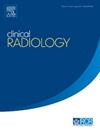精密计算机断层血管造影(CTA)技术在下肢动脉疾病评估中的应用及意义
IF 2.1
3区 医学
Q2 RADIOLOGY, NUCLEAR MEDICINE & MEDICAL IMAGING
引用次数: 0
摘要
目的:本研究比较先进的精密扫描技术和传统的下肢计算机断层血管造影(CTA)扫描方法的图像质量、造影剂剂量和辐射暴露。材料与方法89例疑似下肢动脉疾病患者随机分为精确(A)和传统(B) CTA扫描组。A组使用可变螺距(VHP), B组使用标准螺距扫描技术。评估两组患者腰椎(腹主动脉)、髂动脉、腘动脉、踝关节和足背等5个解剖位置的ct值和图像噪声。计算每个片段的信噪比(SNR)和噪声对比比(CNR),并进行统计分析。结果主观评价(信噪比、CNR和CT值)和客观评价(两名放射线医师的评价分数)均显示A组下肢动脉图像质量优于B组。主观指标在下肢CTA,尤其是踝关节和足背图像上明显高于B组(p < 0.001), A组主观评分比B组高21% (p < 0.05)。在患者放射剂量和造影剂剂量方面,A组与B组相比,放射剂量减少16.23%,造影剂剂量减少12.28% (P<均为0.001)。结论在CTA扫描中使用VHP可以增强远端血管的显像,提高图像质量,减少辐射暴露和造影剂消耗,具有显著的临床效益。本文章由计算机程序翻译,如有差异,请以英文原文为准。
Application and significance of precise computed tomography angiography (CTA) scanning technology in the assessment of lower extremity arterial diseases
Aims
This study compares image quality, contrast agent dosage, and radiation exposure between an advanced precision scanning technique and traditional computed tomography angiography (CTA) scanning methods of the lower limb.
Materials and Methods
A cohort of 89 patients with suspected lower limb arterial disease was randomly assigned to precise (A) and traditional (B) CTA scanning. group A used variable helical pitch (VHP), while group B used a standard pitch scanning technique. Computed tomography values and image noise were assessed at five anatomical locations, including the lumbar 4 level (abdominal aorta), iliac artery level, popliteal artery level, ankle joint level, and dorsal foot level in both groups. Signal-to-noise ratio (SNR) and contrast-to-noise ratio (CNR) were computed for each segment, followed by statistical analysis.
Results
Both subjective (SNR, CNR, and CT values) and objective evaluations (evaluation scores of two radiologists) demonstrated superior image quality of lower extremity arteries in group A. The subjective metric was significantly higher in lower limb CTA, particularly at the ankle and dorsum of foot images (all P<0.001), and the subjective score for group A was 21% higher than that of group B (P<0.05). In terms of patients' radiation dose and contrast agent dosage, group A exhibited a 16.23% reduction in radiation dose and a 12.28% reduction in contrast agent dosage compared to group B, respectively (both P<0.001).
Conclusion
The use of VHP in CTA scanning enhances distal blood vessel visualisation, improves image quality, and reduces radiation exposure and contrast agent consumption, offering substantial clinical benefits.
求助全文
通过发布文献求助,成功后即可免费获取论文全文。
去求助
来源期刊

Clinical radiology
医学-核医学
CiteScore
4.70
自引率
3.80%
发文量
528
审稿时长
76 days
期刊介绍:
Clinical Radiology is published by Elsevier on behalf of The Royal College of Radiologists. Clinical Radiology is an International Journal bringing you original research, editorials and review articles on all aspects of diagnostic imaging, including:
• Computed tomography
• Magnetic resonance imaging
• Ultrasonography
• Digital radiology
• Interventional radiology
• Radiography
• Nuclear medicine
Papers on radiological protection, quality assurance, audit in radiology and matters relating to radiological training and education are also included. In addition, each issue contains correspondence, book reviews and notices of forthcoming events.
 求助内容:
求助内容: 应助结果提醒方式:
应助结果提醒方式:


